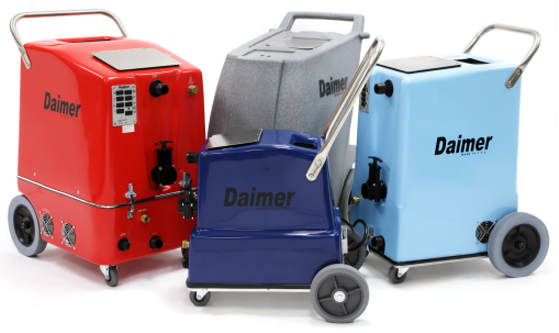Buyer's Guide to Carpet Cleaners
Overview
The common vacuum cleaner uses an electric air pump to suck dirt and dust from carpets. Carpet cleaners, also known as carpet extractors or carpet shampooers, take this cleaning process a step further by injecting a cleaning solution into a rug, agitating it, and then extracting the fluid and dirt. Most carpet cleaners come with attachments, or have options available, that allow them to clean upholstery as well.
Experts recommend using vacuums and carpet cleaners together. To deep clean a carpet with a carpet cleaner, you should first vacuum, then spray with a cleaning solution, and then use the carpet cleaner.
Some carpet cleaners use cold water to clean. Carpet steam cleaners use a built-in heating element to produce hot water with temperatures of up to 210º F for sanitizing applications and for removing the toughest stains. Despite the name, carpet steam cleaners do not clean with steam.
Steam cleaners on the other hand do clean with steam of temperatures up to 360º F and are not appropriate for general use on carpets. Steam cleaners are ideal for sanitizing and cleaning hard surfaces like floors, tile, and machinery. The devices can be used for spot cleaning of carpets that can handle the high temperatures.
Read more about steam cleaners technologies.
Daimer also offers dual-function equipment that includes features for cleaning both carpets and hard surfaces. These machines employ an enclosed multi-jet squeegee wand tool, which allows for non-heated cleaning and simultaneous extraction on sealed vinyl floors, sealed and unsealed concrete, tile, and other sealed and non-sealed surfaces.
Read more about dual-function carpet cleaners with hard-floor capabilities.
Key Features
Temperature:
Some carpet cleaners allow you to add hot water either manually or continuously through a hook up. Others include their own heating elements. Smaller models include a single heating element, heat to lower temperatures, and will take up to 15 minutes to heat. Larger models with two heating elements will hit temperatures of up to 210º F in as little as five minutes.
Temperature Control:
High temperatures provide greater cleaning power and efficiency. However, delicate carpets and those containing natural fibers often cannot handle heat or high temperatures. Some products, such as Daimer's XTreme Power® XPC-9300, allow the operator to adjust the water temperature.
Pressure:
Pressure, measured in pounds per square inch (psi), can also affect cleaning ability of carpet cleaners. For residential and light commercial applications, opt for pressures of 50 to 65 psi. Industrial products consider products up to 500 psi.
Solution Tank and Recovery Tank Size:
Better products include a separate solution tank and recovery tanks. The solution tank contains the cleaning chemicals and the recovery tank holds the used fluid and dirt. Solution tanks for Daimer products range from 4.5 gallons for home and residential products to 17 gallons for commercial/industrial products. Recovery tanks range from four gallons to 15 gallons. Larger the tanks mean the longer periods of non-stop operation.
Low-Flow Technology:
Many Daimer products include low-flow technology, which reduces water waste, prevents mold and mildew, and speeds drying times. For example, the XTreme Power XPC-12000 offers drying times of as little as one hour, which makes it ideal for highly trafficked locations and humid environments.
More Information about Carpet Cleaners
Home and residential carpet cleaners.
Carpet cleaners for auto-detailing.
Comparison chart of carpet cleaners.
Five questions to ask before buying a carpet cleaner.
Environmentally safe, non-toxic carpet cleaning solution called Eco-Green® Carpet Care.
The differences between carpet steam cleaners, steam cleaners, and steam pressure washers.
Learn how a carpet cleaner works.
